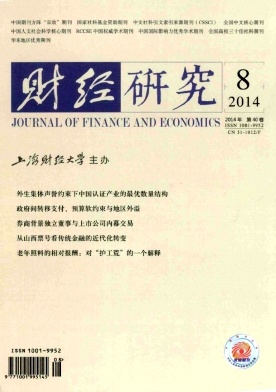外生集体声誉约束下中国认证产业的最优数量结构
财经研究 2014 年 第 40 卷第 08 期, 页码:4 - 15
摘要
参考文献
摘要
中国认证产业存在的最大特殊性在于行业存在制度性的外生集体声誉约束。此文尝试从认证产业的最优数量结构来探讨认证有效性问题,通过一个改进的双重不完全信息重复博弈模型,系统性地在外生集体声誉约束的框架下考察中国认证产业维持"质量卡特尔"的最优认证机构数量问题。我们的研究发现:首先,当认证机构注重未来的长远收益时,认证机构以其集体声誉作为一种可置信承诺,认证行业外生集体声誉的制度设计优于认证机构自设认证标准的个体声誉的制度设计;其次,在外生集体声誉约束下,分享集体声誉的最优认证机构数量是有限制的,最优认证机构数量与认证机构对未来的重视程度存在非线性的正相关关系,与虚假认证的收益存在非线性的负相关关系。因此,增加行业的信号传递效率和虚假认证的惩罚力度将是有效配合集体声誉约束事前机制的有效事后机制。
[1]陈艳莹,杨文璐.集体声誉下最低质量标准的福利效应[J].南开经济研究,2012,(1):134-144.
[2]李金波,聂辉华,沈吉.团队生产、集体声誉和分享规则[J].经济学(季刊),2010,(3):941-960.
[3]刘宗德.基于微观主体行为的认证有效性研究[D].武汉:华中农业大学,2008.
[4]浦徐进,蒋力,刘焕明.农户维护集体品牌的行为分析:个人声誉与组织声誉的互动[J].农业经济问题,2011,(4):99-104.
[5]张琥.集体信誉的理论分析:组织内部逆向选择问题[J].经济研究,2008,(12):124-133.
[6]王丽丽.认证合谋的成因及规制——基于认证市场机构的研究[D].大连:大连理工大学,2010.
[7]Almeida F,Pessali H F,De Paula N M.Third party certification in food market chains:Are you being served?[J].Journal of Economic Issues,2010,44(2):479-486.
[8]Bao Z K.The research of certification effectiveness promoting mechanism under the collective reputation[R].SSRN Working Paper,2014.
[9]Dranove D,Jin Z G.Quality disclosure and certification:Theory and practice[J].Journal of Economic Literature,2010,48(4):935-963.
[10]Evans R A,Guinnane T W.Collective reputation,professional regulation and franchising[R].Cowles Foundation Discussion Paper No.162,2007.
[11]Farhi E,Lerner J,Tirole J.Fear of rejection?Tiered certification and transparency[R].NBER Working Paper No.14457,2008.
[12]Fleckinger P.Collective reputation and market structure:Regulating the quality vs quantity trade-off[R].Centre National De La RechercheScientifique,Working Paper No.26,2007.
[13]Fishman A,Finkelstein I,Simhon A,Yacouel N.The economics of collective brands[R].Bar-Ilan University and Hebrew University,Working Paper No.11,2010.
[14]Hvide H K.Oligopolistic certification[J].The B.E.Journal of Theoretical Economics,2009,9(1):1-21.
[15]Hvide H,Heifetz A.Free entry equilibrium in a market for certifiers[R].SSRN Working Paper No.270418,2001.
[16]Gu Y.Imperfect certification[J].Ruhr Economic Papers,2008,78:235-267.
[17]Guerra A.Gerardocertification disclosure and informational efficiency:A case for ordered rankings of levels[R].University of Oxford Department of Economics Discussion Paper Series,2001.
[18]Jahn G,Schramm M,Spiller A.The reliability of certification:Quality labels as a consumer policy tool[J].Journal of Consumer Policy,2005,28(1):53-73.
[19]Lizzeri A.Information revelation and certification intermediaries[J].The Rand Journal of Economics,1999,30(2):214-231.
[20]Levin J.The Dynamics of collective reputation[J].The B.E.Journal of Theoretical Economics,2009,9(1):1-25.
[21]Miao C H.Competition inequality standards[J].Journal of Industrial Economics,2009,57(1):1-21.
[22]Myslivecek J.How to price imperfect certification[R].Working Paper CERGE-EI No.364,2008.
[23]Mcquade T,Salant S,Winfree J.Quality standard effects on goods with collective reputation and multiple components[R].CERGE-EI Working Paper NO.364,2008.
[24]Peyrache E,Quesada L.Intermediaries,credibility and incentives to collude[J].Journal of Economics&Management Strategy,2011,20(4):1099-1133.
[25]Rouviere E,Soubeyran R.Collective reputation,entry and minimum quality standard[R].FEEM Working Paper No.007,2008.
[26]Saak A.Collective reputation,social norms,and participation[J].American Journal of Agricultural Economics,2012,94(3):763-785.
[27]Strausz R.Honest certification and the threat of capture[J].International Journal of Industrial Organization,2005,23(1-2):45-62.
[28]Skreta V,Veldkamp L.Ratings shopping and asset complexity:A theory of ratings inflation[J].Journal of Monetary Economics,2009,56(5):678-695.
[29]Starobin S,Weinthal E.The search for credible information in social and environmental global governance:The Kosher label[J].Business and Politics,2010,12(3):1-37.
[30]SvítkováK.Prompted to be good:The impact of certification on the quality of charities[R].CERGE-EI Working Paper No.320,2007.
[31]Tirole J.A theory of collective reputations(with applications to the persistence of corruption and to firm quality)[J].Review of Economic Studies,1996,63(1):1-22.
[32]Winfree J A,Mccluskey J.Collective reputation and quality[J].American Journal of Agricultural Economics,2005,87(11):206-213.
1将n=1视为个体声誉的情形,那么随着δ→1,个体声誉最优均衡中个体认证机构违约的存续概率1-Φ(k1+eh-ef)→1。
[2]李金波,聂辉华,沈吉.团队生产、集体声誉和分享规则[J].经济学(季刊),2010,(3):941-960.
[3]刘宗德.基于微观主体行为的认证有效性研究[D].武汉:华中农业大学,2008.
[4]浦徐进,蒋力,刘焕明.农户维护集体品牌的行为分析:个人声誉与组织声誉的互动[J].农业经济问题,2011,(4):99-104.
[5]张琥.集体信誉的理论分析:组织内部逆向选择问题[J].经济研究,2008,(12):124-133.
[6]王丽丽.认证合谋的成因及规制——基于认证市场机构的研究[D].大连:大连理工大学,2010.
[7]Almeida F,Pessali H F,De Paula N M.Third party certification in food market chains:Are you being served?[J].Journal of Economic Issues,2010,44(2):479-486.
[8]Bao Z K.The research of certification effectiveness promoting mechanism under the collective reputation[R].SSRN Working Paper,2014.
[9]Dranove D,Jin Z G.Quality disclosure and certification:Theory and practice[J].Journal of Economic Literature,2010,48(4):935-963.
[10]Evans R A,Guinnane T W.Collective reputation,professional regulation and franchising[R].Cowles Foundation Discussion Paper No.162,2007.
[11]Farhi E,Lerner J,Tirole J.Fear of rejection?Tiered certification and transparency[R].NBER Working Paper No.14457,2008.
[12]Fleckinger P.Collective reputation and market structure:Regulating the quality vs quantity trade-off[R].Centre National De La RechercheScientifique,Working Paper No.26,2007.
[13]Fishman A,Finkelstein I,Simhon A,Yacouel N.The economics of collective brands[R].Bar-Ilan University and Hebrew University,Working Paper No.11,2010.
[14]Hvide H K.Oligopolistic certification[J].The B.E.Journal of Theoretical Economics,2009,9(1):1-21.
[15]Hvide H,Heifetz A.Free entry equilibrium in a market for certifiers[R].SSRN Working Paper No.270418,2001.
[16]Gu Y.Imperfect certification[J].Ruhr Economic Papers,2008,78:235-267.
[17]Guerra A.Gerardocertification disclosure and informational efficiency:A case for ordered rankings of levels[R].University of Oxford Department of Economics Discussion Paper Series,2001.
[18]Jahn G,Schramm M,Spiller A.The reliability of certification:Quality labels as a consumer policy tool[J].Journal of Consumer Policy,2005,28(1):53-73.
[19]Lizzeri A.Information revelation and certification intermediaries[J].The Rand Journal of Economics,1999,30(2):214-231.
[20]Levin J.The Dynamics of collective reputation[J].The B.E.Journal of Theoretical Economics,2009,9(1):1-25.
[21]Miao C H.Competition inequality standards[J].Journal of Industrial Economics,2009,57(1):1-21.
[22]Myslivecek J.How to price imperfect certification[R].Working Paper CERGE-EI No.364,2008.
[23]Mcquade T,Salant S,Winfree J.Quality standard effects on goods with collective reputation and multiple components[R].CERGE-EI Working Paper NO.364,2008.
[24]Peyrache E,Quesada L.Intermediaries,credibility and incentives to collude[J].Journal of Economics&Management Strategy,2011,20(4):1099-1133.
[25]Rouviere E,Soubeyran R.Collective reputation,entry and minimum quality standard[R].FEEM Working Paper No.007,2008.
[26]Saak A.Collective reputation,social norms,and participation[J].American Journal of Agricultural Economics,2012,94(3):763-785.
[27]Strausz R.Honest certification and the threat of capture[J].International Journal of Industrial Organization,2005,23(1-2):45-62.
[28]Skreta V,Veldkamp L.Ratings shopping and asset complexity:A theory of ratings inflation[J].Journal of Monetary Economics,2009,56(5):678-695.
[29]Starobin S,Weinthal E.The search for credible information in social and environmental global governance:The Kosher label[J].Business and Politics,2010,12(3):1-37.
[30]SvítkováK.Prompted to be good:The impact of certification on the quality of charities[R].CERGE-EI Working Paper No.320,2007.
[31]Tirole J.A theory of collective reputations(with applications to the persistence of corruption and to firm quality)[J].Review of Economic Studies,1996,63(1):1-22.
[32]Winfree J A,Mccluskey J.Collective reputation and quality[J].American Journal of Agricultural Economics,2005,87(11):206-213.
1将n=1视为个体声誉的情形,那么随着δ→1,个体声誉最优均衡中个体认证机构违约的存续概率1-Φ(k1+eh-ef)→1。
引用本文
陈艳莹, 鲍宗客. 外生集体声誉约束下中国认证产业的最优数量结构[J]. 财经研究, 2014, 40(8): 4–15.
导出参考文献,格式为:





 8321
8321  3941
3941

